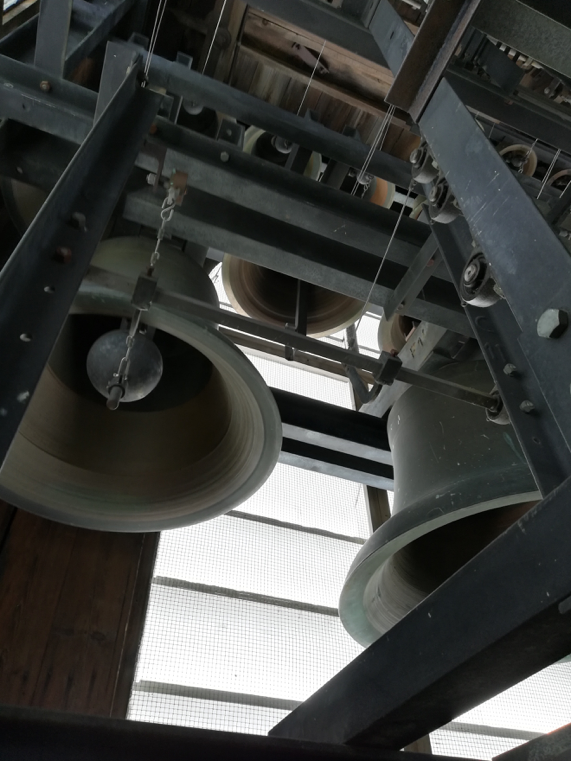The Secret Behind Mead Chapel’s Bells at Middlebury College 米德教堂钟的秘密
Note: This bilingual English-Chinese article was originally published in the May-June 2019 issue of The Bell Tower, which is the official publication of The American Bell Association International, Inc. To learn more about them, please check out their website.
Have you ever wondered why every Friday evening you can hear Mead Chapel’s bells ringing? Maybe you haven’t, but I certainly have! I’d always wonder, who was this mysterious person who would come every Friday to ring the bells. Every week around this time, I’d explore the insides of the chapel to no avail, and it seemed that no one seemed to know who it was.
你常常想不想过为什么每一个礼拜五晚上你可以听到米德教堂的种声?你可能没想过,可是我肯定想过!我一直在想,谁是这个后面钟声的神秘人物。每个礼拜在这个时段我去米德教堂的里面寻找这个教堂的秘密,可是每次我运气都不太好,并且好像没有人知道神秘人物是谁。
However, this last Sunday noon I finally got the chance to meet the person at the center of this mystery, Mr. George Matthew Jr., and I learned that the bells that we can hear every Friday evening are actually part of an instrument called a carillon. Mr. Matthew is the Carillonneur for both Middlebury College and Norwich University, and has been playing the carillon for well over sixty years. He led me to a secret door on the second floor (unsurprising for a building as old as Mead Chapel), that lead to where the carillon and its bells are.
然而,明德中文学校的第六个星期我终于有机会跟这位神秘人物见面。他的名字是乔治马太先生,而且我发现每一个礼拜五可以听到的钟声是一种乐器[钟琴]的一部分。马太先生是米德尔佰里大学和诺威治大学的钟琴家,以及他弹钟琴已经弹了六十年多了。他带我到二楼的一个秘密的门(像米德教堂这样古老的建筑而言,有一个秘密的门并不能让人惊讶),这倒门通往了钟琴钟声的位置。
George Matthew Jr. playing the carillon at Mead Chapel, Middlebury University.
The bells at Mead Chapel, Middlebury University.
As a student at the Chinese School, I’m well aware that music is often called the universal language, but as someone who’s never been too into music and musical instruments, I never put much stock into that common saying. However, hearing Mr. Matthew play the carillon was both a solemn and lively experience that definitely allowed me to understand the meaning behind this aphorism. He afterwards described a magical scene to me he saw once of the carillon playing on a mid-summer night in Belgium, where Jeff Denijn's "Unwritten Prelude" opens a carillon recital, the stars are just coming out, it's beautifully cool and everyone is sitting at outdoor restaurants called "terraces," as well as drinking beer and eating hors d'oeuvres. I think that due to its history and distinct sound, that scene probably more than anything else gives a good idea as to what kind of sentiments the music of the carillon evokes. No matter where you are in the world, as clichéd as it sounds, music really does appear to transcend borders, and that is the ideal I figure we here at the Chinese School should attempt to follow: building bridges with our language wherever we go.
身为明德中文学校的学生,我当然知道音乐也是一种的语言,也有人叫做[万能的语言],可是由于身为对音乐和乐器没那么大兴趣的人,我从来没有反复思考这个比喻的意思。不过,听着马太先生弹钟琴是一个极深洞又严肃的经验,这让我完全理解这个比喻的含义。他弹钟琴以后他描述了一个他以前看过神奇的情景:在比利时仲夏的夜晚,某个人弹了钟琴,他演奏[Jeff Denijn的 "Unwritten Prelude"],星星出来了,天气极美丽又凉快,每个人坐在露天饭馆 ,而且大家大吃大喝。我认为由于钟琴的历史和特别的声音,因此这个描述比别的故事更能表示钟琴给人们带来的感受 。无论你在这个世界的那一个角落,虽然这样说有点俗套,但是我还是想说音乐仿佛超越了边界。不仅如此,我也觉得我们中文学校的学生应该跟着这个想法:无论我们去那里,我们都用语言的能力建立沟通的桥。
And on that note, despite the fact that most of them are found in North America and Europe, Mr. Matthew stated that the popularity of carillons has been rising around the world in the last few decades, and actually, this year China finally got its first carillon in Beijing. Who knows, perhaps one of you will be lucky enough to play it some day?
尽管大部分世界的钟琴在欧州和北美州,马太先生仍然说过去的几十年里,钟琴在世界上越来越流行,中国北京今年就收到第一部钟琴 。谁知道,也许你们运气好,可能就有机会弹这部钟琴。





